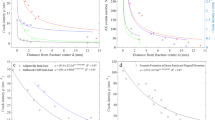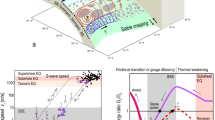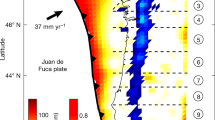Abstract
Recently, a series of unusual earthquake phenomena have been discovered, including deep episodic tremor1, low-frequency earthquakes2, very-low-frequency earthquakes3, slow slip events4 and silent earthquakes5,6,7,8,9. Each of these has been demonstrated to arise from shear slip, just as do regular earthquakes, but with longer characteristic durations and radiating much less seismic energy. Here we show that these slow events follow a simple, unified scaling relationship that clearly differentiates their behaviour from that of regular earthquakes. We find that their seismic moment is proportional to the characteristic duration and their moment rate function is constant, with a spectral high-frequency decay of f-1. This scaling and spectral behaviour demonstrates that they can be thought of as different manifestations of the same phenomena and that they comprise a new earthquake category. The observed scale dependence of rupture velocity for these events can be explained by either a constant low-stress drop model or a diffusional constant-slip model. This new scaling law unifies a diverse class of slow seismic events and may lead to a better understanding of the plate subduction process and large earthquake generation.
This is a preview of subscription content, access via your institution
Access options
Subscribe to this journal
Receive 51 print issues and online access
$199.00 per year
only $3.90 per issue
Buy this article
- Purchase on Springer Link
- Instant access to full article PDF
Prices may be subject to local taxes which are calculated during checkout



Similar content being viewed by others
References
Obara, K. Nonvolcanic deep tremor associated with subduction in southwest Japan. Science 296, 1679–1681 (2002)
Katsumata, A. & Kamaya, N. Low-frequency continuous tremor around the Moho discontinuity away from volcanoes in the southwest Japan. Geophys. Res. Lett. 30 doi: 10.1029/2002GL015981 (2003)
Ito, Y., Obara, K., Shiomi, K., Sekine, S. & Hirose, H. Slow earthquakes coincident with episodic tremors and slow slip events. Science 26, 503–506 (2006)
Hirose, H. & Obara, K. Repeating short- and long-term slow slip events with deep tremor activity, around the Bungo channel region, southwest Japan. Earth Planets Space 57, 961–972 (2005)
Hirose, H., Hirahara, K., Kimata, F., Fujii, N. & Miyazaki, S. A slow thrust slip event following the two 1996 Hyuganada earthquakes beneath the Bungo Channel, southwest Japan. Geophys. Res. Lett. 26, 3237–3240 (1999)
Kawasaki, I. et al. The 1992 Sanriku-oki, Japan, ultra-slow earthquake. J. Phys. Earth 43, 105–116 (1995)
Kawasaki, I., Asai, Y. & Tamura, Y. Space-time distribution of interplate moment release including slow earthquakes and seismo-geodetic coupling in the Sanriku-oki region along the Japan trench. Tectonophysics 330, 267–283 (2001)
Ozawa, S. et al. Detection and monitoring of ongoing aseismic slip in the Tokai region, central Japan. Science 298, 1009–1012 (2002)
Kostoglodov, V. et al. A large silent earthquake in the Guerrero seismic gap, Mexico. Geophys. Res. Lett. 30 doi: 10.1029/2003GL017219 (2003)
Obara, K., Kasahara, K., Hori, S. & Okada, Y. A densely distributed high-sensitivity seismograph network in Japan: Hi-net by National Research Institute for Earth Science and Disaster Prevention. Rev. Sci. Instrum. 76 doi: 10.1063/1.1854197 (2005)
Dragert, H., Wang, K. & Rogers, G. Geodetic and seismic signatures of episodic tremor and slip in the northern Cascadia subduction zone. Earth Planets Space 56, 1143–1150 (2004)
Baba, T., Tanioka, T., Cummins, P. R. & Uhira, K. The slip distribution of the 1946 Nankai earthquake estimated from tsunami inversion using a new plate model. Phys. Earth Planet. Inter. 132, 59–73 (2002)
Shelly, D. R., Beroza, G. C. & Ide, S. Non-volcanic tremor and low frequency earthquake swarms. Nature 446, 305–307 (2007)
Shelly, D. R., Beroza, G. C., Ide, S. & Nakamula, S. Low-frequency earthquakes in Shikoku, Japan, and their relationship to episodic tremor and slip. Nature 442, 188–191 (2006)
Ide, S., Shelly, D. R. & Beroza, G. C. The mechanism of deep low frequency earthquakes: further evidence that deep non-volcanic tremor is generated by shear slip on the plate interface. Geophys. Res. Lett. 34 doi: 10.1029/2006GL028890 (2007)
Ando, M. A fault model of the 1946 Nankaido earthquake derived from tsunami data. Phys. Earth Planet. Inter. 28, 320–336 (1982)
DeMets, C., Gordon, R. G., Argus, D. F. & Stein, S. Effect of recent revisions to the geomagnetic reversal time scale on estimates of current plate motions. Geophys. Res. Lett. 21, 2191–2194 (1994)
Houston, H. Influence of depth, focal mechanism, and tectonic setting on the shape and duration of earthquake source time functions. J. Geophys. Res. 106, 11137–11150 (2001)
Shibazaki, B. & Iio, Y. On the physical mechanism of silent slip events along the deeper part of the seismic zone. Geophys. Res. Lett. 30 doi: 10.1029/2003GL017047 (2003)
Barenblatt, G. I. Scaling, Self-similarity, and Intermediate Asymptotics (Cambridge Univ. Press, Cambridge, UK, 1996)
Gladwin, M. T., Gwyther, R. L., Hart, R. H. G. & Brechenridge, K. S. Measurements of the strain field associated with episodic creep events on the San Andreas fault at San Juan Bautista, California. J. Geophys. Res. 99, 4559–4564 (1994)
Linde, A. T., Gladwin, M. T., Johnston, M. J. S., Gwyther, R. L. & Bilham, R. G. A slow earthquake sequence on the San Andreas fault. Nature 383, 65–67 (1996)
Crescentini, L., Amoruso, A. & Scarpa, R. Constraints on slow earthquake dynamics from a swarm in central Italy. Science 286, 2132–2134 (1999)
Amoruso, A., Crescentini, L., Morelli, A. & Scarpa, R. Slow rupture of an aseismic fault in a seismogenic region of Central Italy. Geophys. Res. Lett. 29 doi: 10.1029/2002GL016027 (2002)
Segall, P., Desmarais, E. K., Shelly, D., Mikilius, A. & Cervelli, P. Earthquakes triggered by silent slip events on Kilauea volcano, Hawaii. Nature 442, 71–74 (2006)
Ito, Y. & Obara, K. Very low frequency earthquakes within accretionary prisms are very low-stress-drop earthquakes. Geophys. Res. Lett. 33 doi: 10.1029/2006GL025883 (2006)
Heki, K., Miyazaki, S. & Tsuji, H. Silent fault slip following an interplate thrust earthquake at the Japan Trench. Nature 386, 595–597 (1997)
Dieterich, J. H. Modelling of rock friction: 1 Experimental results and constitutive equations. J. Geophys. Res. 84, 2161–2168 (1979)
Ruina, A. L. Slip instability and state variable friction laws. J. Geophys. Res. 88, 10,359–10,370 (1983)
Liu, Y. & Rice, J. R. Aseismic slip transients emerge spontaneously in three-dimensional rate and state modeling of subduction earthquake sequences. J. Geophys. Res. 110 doi: 10.1029/2004JB003424 (2005)
Sagiya, T. & Thatcher, W. Coseismic slip resolution along a plate boundary megathrust: the Nankai Trough, southwest Japan. J. Geophys. Res. 104, 1113–1129 (1999)
Acknowledgements
We thank J. Vidale for comments. This work is supported by a Grant-in-Aid for Scientific Research, the Ministry of Education, Sports, Science and Technology, Japan, and the National Science Foundation.
Author information
Authors and Affiliations
Corresponding author
Ethics declarations
Competing interests
Reprints and permissions information is available at www.nature.com/reprints. The authors declare no competing financial interests.
Rights and permissions
About this article
Cite this article
Ide, S., Beroza, G., Shelly, D. et al. A scaling law for slow earthquakes. Nature 447, 76–79 (2007). https://doi.org/10.1038/nature05780
Received:
Accepted:
Issue Date:
DOI: https://doi.org/10.1038/nature05780
This article is cited by
-
Tremor along the Dead Sea Transform remotely triggered by the 2023 MW7.6 Kahramanmaraş earthquake
Communications Earth & Environment (2024)
-
Laboratory Fracture Slip and Seismicity Subjected to Fluid Injection-Related Stress and Pressure Paths
Rock Mechanics and Rock Engineering (2024)
-
Cyclic shear behavior of dredged soil under constant normal stress conditions
Environmental Earth Sciences (2024)
-
Eight-year catalog of deep short-term slow slip events at the Nankai trough based on objective detection algorithm using strain and tilt records
Earth, Planets and Space (2023)
-
A review on slow earthquakes in the Japan Trench
Progress in Earth and Planetary Science (2023)
Comments
By submitting a comment you agree to abide by our Terms and Community Guidelines. If you find something abusive or that does not comply with our terms or guidelines please flag it as inappropriate.



